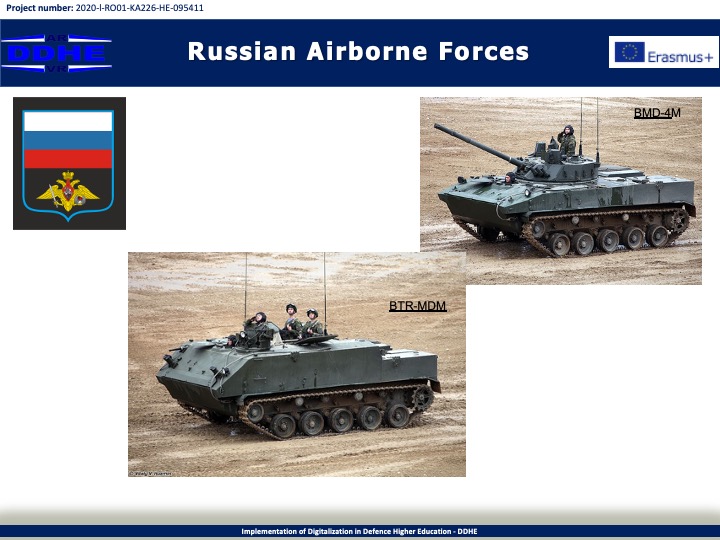There are over 1,800* armored fighting vehicles, mostly BMD-1 (since 1969), of which all but around 100 are in storage, and at least several hundred BMD-2 (since 1985). There are over 100 BMD-3 (1990) that were partially upgraded to BMD-4 level. All of them are amphibious, moving at around 10 km/h in water. The BMD-4 is capable of full, continuous fire while in deep water, unlike any other vehicle with such heavy weaponry (100 mm gun and 30 mm auto cannon). However, some units (such as those who served on peacekeeping duties in the Balkans) are known to have used BTR armored personnel carriers rather than BMD's. T-72B3 tanks supplied to the Russian Airborne Forces in 2018 have been upgraded and are equipped with Andromeda automatic control system and some of them with top-attack defence screens. As of 2021, the Russian Airborne Forces have 150 T-72B3 and 10 T-72B3 mod. 2016.
There is a turret-less variant of the BMD-1, the BTR-D, which is used as troop carrier and serves as the basis for specialised versions such as anti-tank, command and signals. The BTR-D will be partially replaced by the new multi-purpose APC BTR-MD "Rakushka" that will also come in several different versions. Approximately 280 vehicles in all BTR-D configurations are in service. As part of the 2011 state defence order (GOZ), 10 BMD-4M and 10 "Rakushka's" have been ordered, but according to the VDV's CinC General Colonel Shamanov, Kurganmashzavod did not give a guarantee it would produce them.
The Russian Defense Ministry adopted the BMD-4M in early December 2012. They are planning to receive 10 BMD-4M vehicles and 10 BTR-MD vehicles for final testing by mid-2013, with commissioning by the end of 2013. The Russian Airborne plans to acquire 1,000 BMD-4Ms through 2020. The first production batch of the new armored vehicles BMD-4M and BTR-MDM "Shell" in the amount of 24 units (12 each) transferred to the Russian Airborne Forces in 2015. The VDV equipped the first regiment with BMD-4Ms and BTR-MDMs in 2016. In 2017, they received two battalion sets of BMD-4M combat airborne vehicles and BTR-MDM APCs, over 80 Rys’ and UAZ Pickup armored automobiles.
